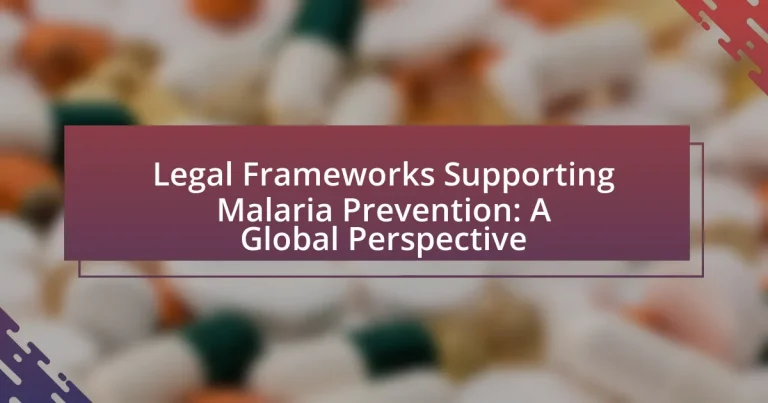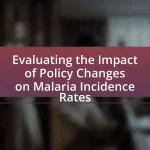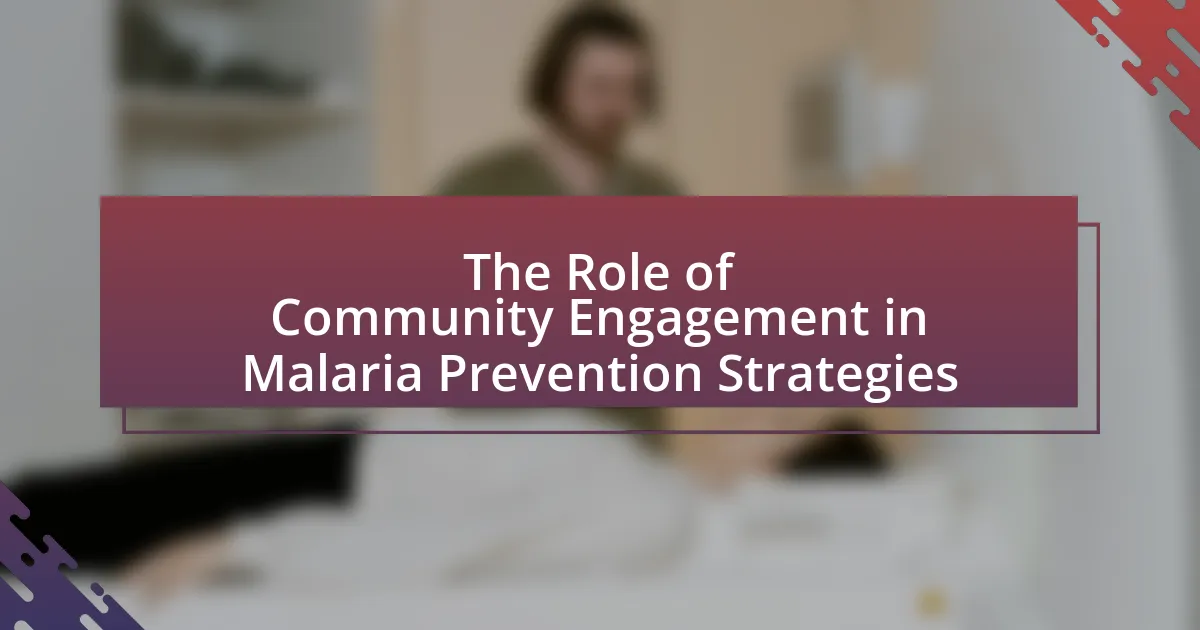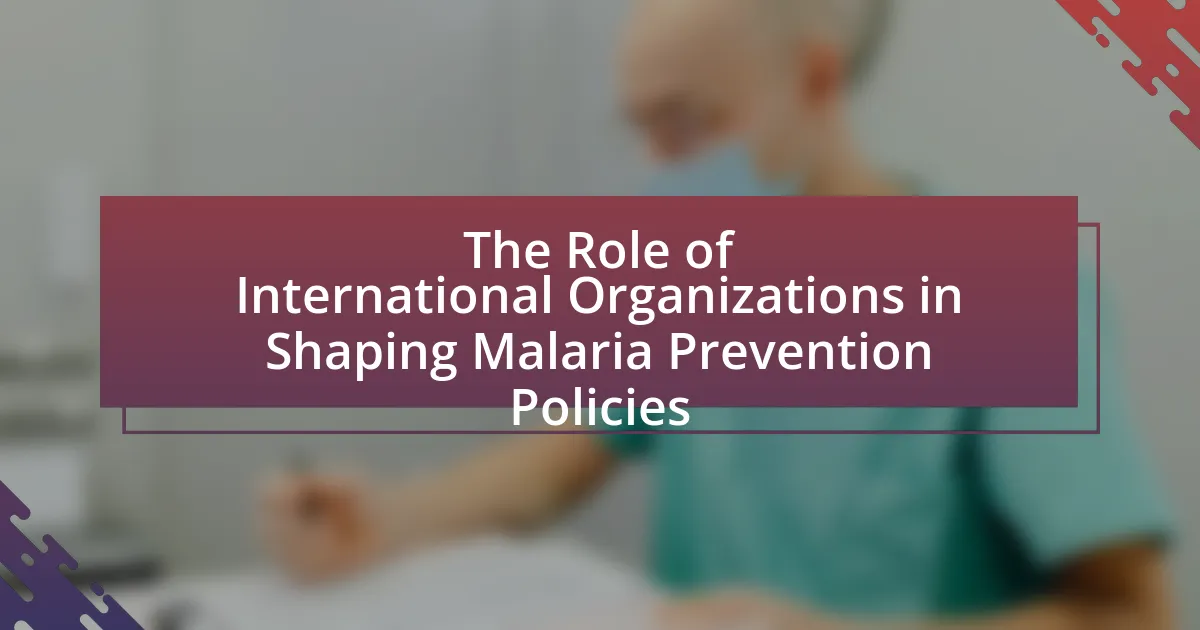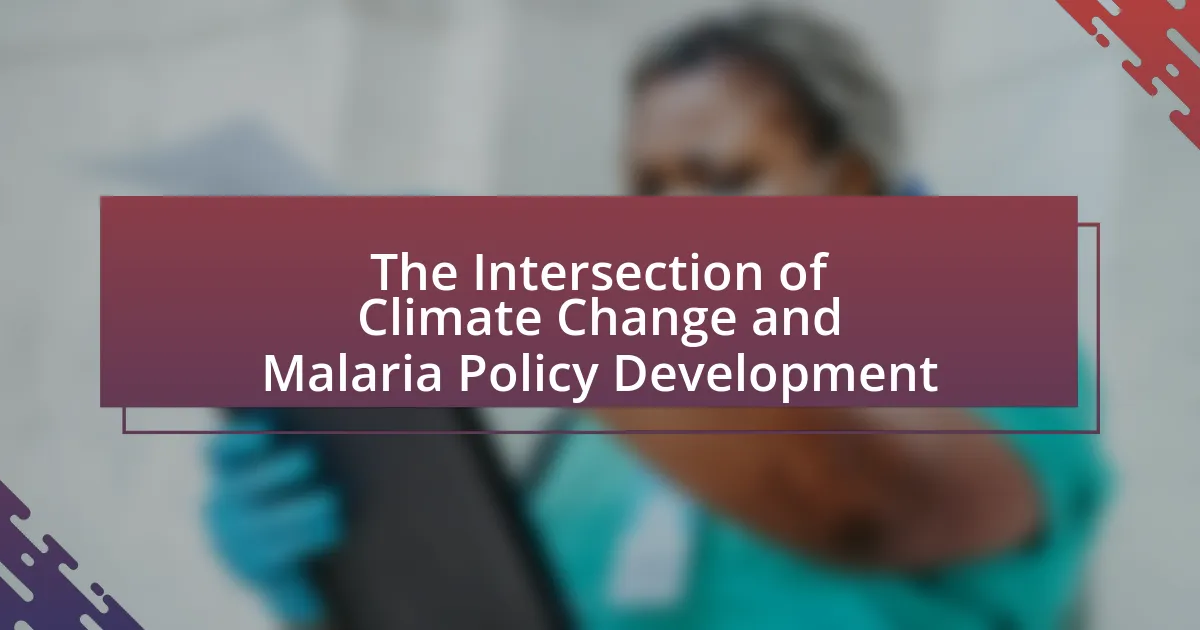The article focuses on the legal frameworks supporting malaria prevention globally, highlighting key international treaties and national laws that facilitate effective malaria control. It discusses the World Health Organization’s Global Technical Strategy for Malaria 2016-2030, the International Health Regulations, and various national policies that align with these international commitments. The article also examines the role of regional agreements, the challenges in implementing legal frameworks, and the importance of stakeholder engagement and education in enhancing compliance and effectiveness of malaria prevention laws. Additionally, it explores innovative approaches and best practices that can strengthen legal frameworks to combat malaria effectively.
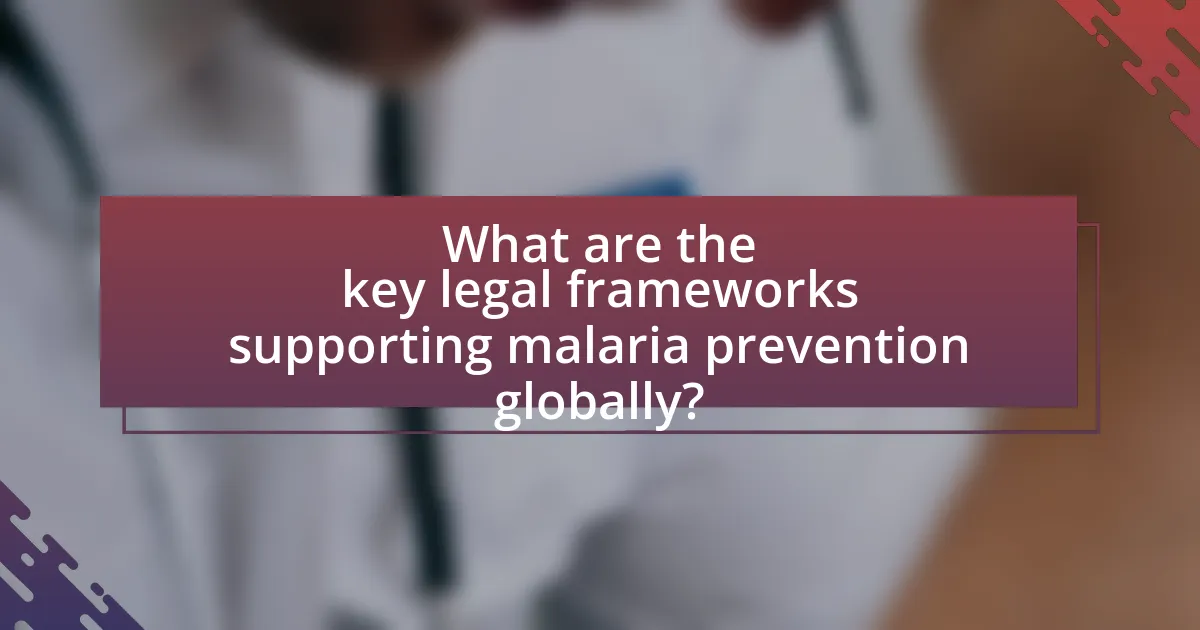
What are the key legal frameworks supporting malaria prevention globally?
The key legal frameworks supporting malaria prevention globally include the World Health Organization’s Global Technical Strategy for Malaria 2016-2030, the International Health Regulations (IHR), and various national laws and policies that align with international commitments. The Global Technical Strategy outlines specific targets and actions for malaria control and elimination, emphasizing the need for integrated approaches and multisectoral collaboration. The IHR provides a legal basis for countries to report and respond to public health emergencies, including malaria outbreaks, ensuring coordinated international efforts. National laws often incorporate guidelines from these international frameworks, facilitating local implementation of malaria prevention strategies, such as vector control and access to treatment.
How do international treaties influence malaria prevention efforts?
International treaties significantly enhance malaria prevention efforts by establishing collaborative frameworks and funding mechanisms among nations. These treaties, such as the Global Fund to Fight AIDS, Tuberculosis and Malaria, facilitate resource allocation and technical support, enabling countries to implement effective malaria control strategies. For instance, the World Health Organization’s Global Technical Strategy for Malaria 2016-2030, endorsed by member states, sets ambitious targets for malaria reduction and promotes international cooperation. This collaborative approach has led to a 27% decrease in malaria incidence globally between 2010 and 2019, demonstrating the tangible impact of international agreements on public health outcomes.
What specific treaties address malaria control and prevention?
The specific treaties that address malaria control and prevention include the World Health Organization’s Global Malaria Strategy and the Roll Back Malaria Partnership. The Global Malaria Strategy, adopted by WHO, outlines comprehensive approaches for malaria prevention and control, emphasizing the need for international cooperation and commitment. The Roll Back Malaria Partnership, established in 1998, aims to reduce malaria morbidity and mortality through coordinated efforts among countries, international organizations, and stakeholders. These treaties provide a framework for collaborative action and resource mobilization to combat malaria effectively.
How do these treaties facilitate cooperation among nations?
Treaties facilitate cooperation among nations by establishing legally binding agreements that promote collaborative efforts in malaria prevention. These agreements often include shared goals, resource allocation, and coordinated strategies, which enhance collective action against malaria. For instance, the World Health Organization’s Global Technical Strategy for Malaria 2016-2030 encourages countries to work together by setting common targets and facilitating data sharing, thereby strengthening regional responses to malaria outbreaks. This collaborative framework is essential for pooling resources and expertise, ultimately leading to more effective malaria control and elimination efforts.
What role do national laws play in malaria prevention?
National laws play a critical role in malaria prevention by establishing regulatory frameworks that govern public health initiatives, vector control measures, and access to treatment. These laws enable governments to implement strategies such as mandatory reporting of malaria cases, funding for research and development of vaccines, and the regulation of insecticides used for vector control. For instance, countries with strong legal frameworks, like Nigeria, have seen improvements in malaria control through legislation that supports community health programs and ensures the availability of antimalarial drugs. Such laws are essential for coordinating efforts among various stakeholders, including health ministries, non-governmental organizations, and international partners, thereby enhancing the overall effectiveness of malaria prevention strategies.
How are national malaria control programs structured legally?
National malaria control programs are structured legally through a combination of national legislation, international agreements, and public health policies. These legal frameworks establish the responsibilities of government entities, define funding mechanisms, and outline the roles of various stakeholders in malaria prevention and control efforts. For instance, many countries have enacted specific laws that mandate the establishment of national malaria control strategies, often aligning with guidelines set by the World Health Organization. This alignment ensures that national programs adhere to global standards and best practices, facilitating international cooperation and funding opportunities.
What are the legal obligations of governments in malaria-endemic regions?
Governments in malaria-endemic regions are legally obligated to implement and enforce public health measures aimed at malaria prevention and control. These obligations include ensuring access to effective malaria treatment, promoting vector control strategies, and facilitating public health education to raise awareness about malaria transmission and prevention methods.
For instance, the World Health Organization’s Global Technical Strategy for Malaria 2016-2030 outlines that countries must develop national malaria control programs, allocate resources for malaria research, and engage in international cooperation to combat malaria. Additionally, international human rights frameworks, such as the International Covenant on Economic, Social and Cultural Rights, obligate governments to ensure the right to health, which encompasses the prevention and treatment of malaria.
How do regional agreements enhance malaria prevention strategies?
Regional agreements enhance malaria prevention strategies by fostering collaboration among countries, enabling coordinated responses to malaria outbreaks, and facilitating resource sharing. These agreements, such as the Southern African Development Community (SADC) Malaria Strategic Plan, promote joint initiatives that align national policies with regional goals, ensuring a unified approach to vector control, treatment access, and surveillance. For instance, the World Health Organization’s Global Technical Strategy for Malaria 2016-2030 emphasizes the importance of regional cooperation in achieving malaria elimination targets, highlighting that countries working together can effectively reduce transmission rates and improve health outcomes.
What examples of regional collaborations exist for malaria control?
Regional collaborations for malaria control include the African Leaders Malaria Alliance (ALMA), which unites African heads of state to enhance malaria prevention and treatment efforts across the continent. Another example is the Southern African Development Community (SADC), which implements joint strategies for malaria elimination in member states. Additionally, the Asia Pacific Leaders Malaria Alliance (APLMA) focuses on regional cooperation to reduce malaria incidence in Asia and the Pacific. These collaborations are supported by initiatives such as the Global Fund to Fight AIDS, Tuberculosis and Malaria, which provides funding and resources to bolster these regional efforts.
How effective are these regional agreements in reducing malaria cases?
Regional agreements have proven effective in reducing malaria cases by facilitating coordinated efforts in prevention, treatment, and surveillance across borders. For instance, the African Union’s Malaria Strategy aims to reduce malaria morbidity and mortality by 75% by 2025, which has led to significant declines in malaria cases in participating countries. A study published in the Lancet Infectious Diseases highlighted that countries collaborating under the Southern African Development Community (SADC) framework reported a 30% reduction in malaria cases over five years due to shared resources and strategies. These agreements enhance resource mobilization, improve access to diagnostics and treatment, and promote community engagement, all contributing to the overall effectiveness in combating malaria.
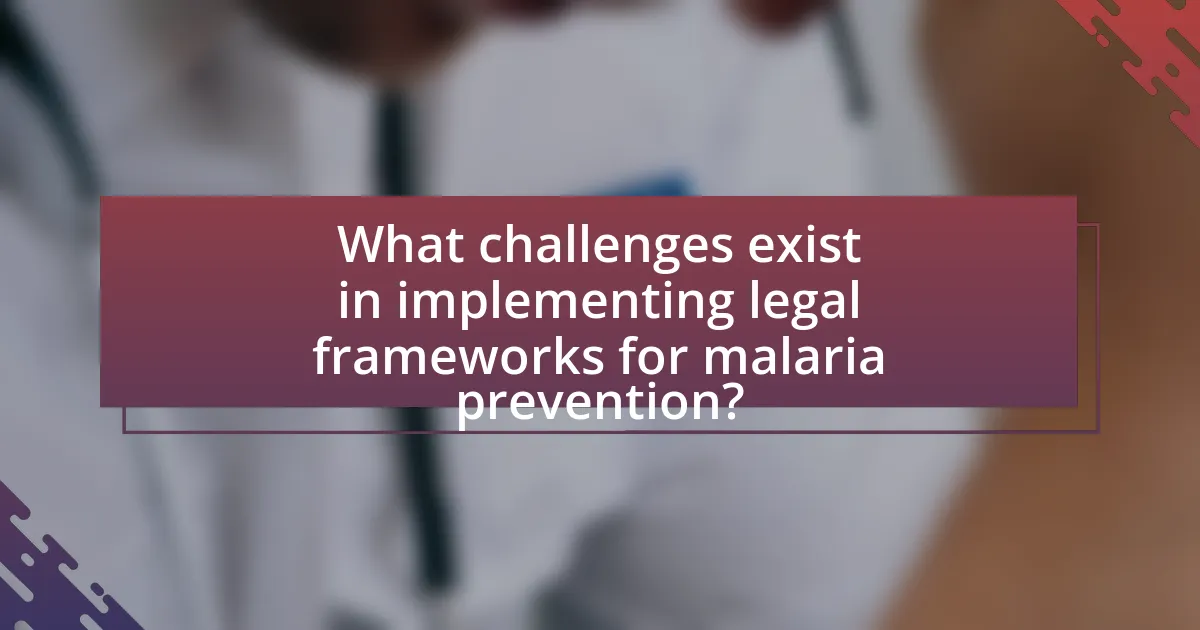
What challenges exist in implementing legal frameworks for malaria prevention?
Implementing legal frameworks for malaria prevention faces several challenges, including inadequate funding, lack of political will, and insufficient public awareness. In many regions, governments struggle to allocate necessary resources for effective malaria control programs, which hampers the enforcement of legal measures. Additionally, political instability or competing priorities can diminish the commitment to malaria prevention initiatives. A study by the World Health Organization highlights that countries with strong political support and funding are more successful in implementing effective malaria prevention strategies. Furthermore, public awareness campaigns are often lacking, leading to low community engagement and compliance with malaria prevention laws. These factors collectively hinder the successful implementation of legal frameworks aimed at combating malaria.
What are the common barriers to effective legal enforcement?
Common barriers to effective legal enforcement include lack of resources, insufficient training for enforcement personnel, and inadequate legal frameworks. Lack of resources, such as funding and personnel, hampers the ability of legal systems to enforce laws effectively. Insufficient training for enforcement personnel leads to inconsistent application of laws and regulations, which undermines their effectiveness. Inadequate legal frameworks may result in gaps or ambiguities in the law, making enforcement challenging. For instance, a study by the World Health Organization highlights that countries with limited financial resources struggle to implement and enforce malaria prevention laws, leading to increased transmission rates.
How do resource limitations affect legal frameworks for malaria prevention?
Resource limitations significantly hinder the effectiveness of legal frameworks for malaria prevention by restricting funding, personnel, and infrastructure necessary for implementation. For instance, countries with limited financial resources often struggle to enforce existing laws or develop new regulations aimed at controlling malaria, leading to inadequate vector control measures and insufficient access to preventive treatments. According to the World Health Organization, in regions where funding for malaria programs is low, the incidence of malaria remains high, demonstrating a direct correlation between resource allocation and the success of legal frameworks.
What role does political will play in the enforcement of malaria laws?
Political will is crucial for the effective enforcement of malaria laws, as it determines the prioritization of resources and commitment to public health initiatives. When political leaders demonstrate strong support for malaria prevention, it leads to the allocation of necessary funding, the establishment of comprehensive policies, and the mobilization of community engagement. For instance, countries with robust political will, such as Rwanda, have successfully implemented malaria control strategies, resulting in a significant reduction of malaria cases by over 80% from 2005 to 2018. This demonstrates that political will directly influences the success of malaria laws and their enforcement, ultimately impacting public health outcomes.
How do cultural factors impact the effectiveness of legal frameworks?
Cultural factors significantly impact the effectiveness of legal frameworks by influencing public perception, compliance, and enforcement of laws. For instance, in regions where traditional beliefs about health and illness prevail, legal measures aimed at malaria prevention may be less effective if they conflict with local customs or practices. A study published in the “International Journal of Health Policy and Management” by authors Mohit Bhandari and Ranjit Singh highlights that community engagement and culturally sensitive approaches enhance the acceptance of health laws, thereby improving compliance rates. This demonstrates that legal frameworks must align with cultural contexts to achieve desired health outcomes, such as reducing malaria incidence.
What cultural beliefs may hinder malaria prevention efforts?
Cultural beliefs that may hinder malaria prevention efforts include the perception that malaria is caused by supernatural forces rather than by mosquito bites. This belief can lead individuals to rely on traditional healing practices instead of seeking medical treatment or preventive measures such as insecticide-treated nets. Additionally, some communities may view the use of modern medicine as a violation of cultural norms, resulting in resistance to interventions like vaccination or antimalarial drugs. Studies have shown that in regions where such beliefs are prevalent, malaria transmission rates remain high, as adherence to preventive measures is significantly reduced.
How can legal frameworks be adapted to respect local customs?
Legal frameworks can be adapted to respect local customs by incorporating community input during the legislative process and ensuring that laws reflect the cultural practices and beliefs of the local population. This approach has been demonstrated in various countries where participatory governance models have been employed, allowing local stakeholders to influence health policies, including those related to malaria prevention. For instance, in Uganda, the integration of traditional healers into the healthcare system has improved community acceptance of malaria interventions, showcasing the effectiveness of aligning legal frameworks with local customs.
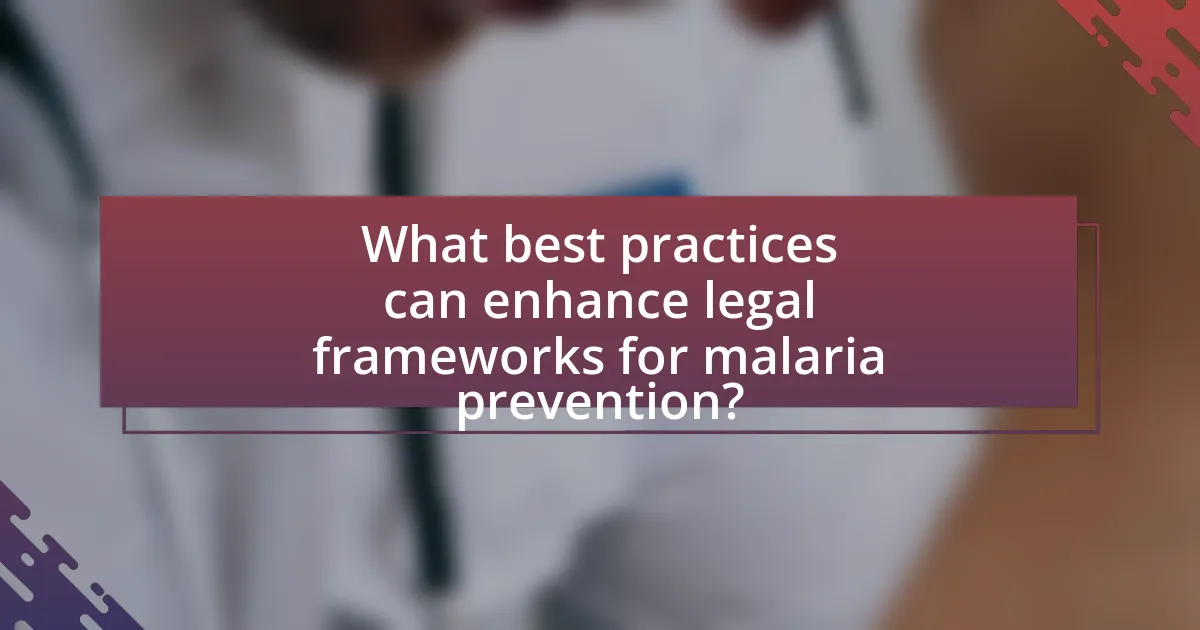
What best practices can enhance legal frameworks for malaria prevention?
Best practices that can enhance legal frameworks for malaria prevention include the establishment of comprehensive legislation that mandates vector control measures, promotes access to preventive treatments, and ensures funding for malaria programs. Countries like Rwanda have implemented laws that require local governments to engage in regular mosquito control activities, which has significantly reduced malaria incidence. Additionally, integrating malaria prevention into broader public health policies and ensuring community involvement in decision-making processes can strengthen legal frameworks. Evidence from the World Health Organization indicates that countries with robust legal frameworks experience lower malaria transmission rates, highlighting the effectiveness of these practices.
How can stakeholder engagement improve malaria prevention laws?
Stakeholder engagement can improve malaria prevention laws by ensuring that the perspectives and needs of affected communities are incorporated into policy-making. Engaging stakeholders, such as local health authorities, community leaders, and affected populations, fosters collaboration and enhances the relevance of laws to local contexts. For instance, studies have shown that when communities are involved in the development of health policies, compliance and effectiveness increase, as seen in various malaria control programs in sub-Saharan Africa. This participatory approach leads to more tailored interventions, ultimately resulting in better health outcomes and more sustainable malaria prevention efforts.
What strategies can be employed to involve local communities in malaria control?
To involve local communities in malaria control, strategies such as community education, participatory planning, and local leadership engagement can be employed. Community education initiatives raise awareness about malaria transmission and prevention methods, which has been shown to increase knowledge and reduce incidence rates. Participatory planning involves local stakeholders in decision-making processes, ensuring that interventions are culturally appropriate and effectively address community needs. Engaging local leaders fosters trust and encourages community participation, as evidenced by successful programs in various regions where local leadership has mobilized resources and support for malaria control efforts.
How can partnerships with NGOs strengthen legal frameworks?
Partnerships with NGOs can strengthen legal frameworks by providing expertise, resources, and grassroots insights that enhance policy development and implementation. NGOs often have specialized knowledge in public health and community engagement, which can inform the creation of more effective malaria prevention laws. For instance, the World Health Organization has recognized the role of NGOs in mobilizing communities and advocating for legal reforms that support health initiatives, leading to improved compliance and outcomes in malaria control efforts. This collaboration can result in more comprehensive legal frameworks that address the specific needs of affected populations, ultimately leading to better health outcomes and more effective malaria prevention strategies.
What innovative approaches are being used to enforce malaria prevention laws?
Innovative approaches to enforce malaria prevention laws include the use of mobile technology for monitoring and reporting compliance. For instance, countries like Kenya have implemented mobile applications that allow health workers to report malaria cases and treatment outcomes in real-time, enhancing data accuracy and response times. Additionally, community engagement initiatives, such as training local leaders to advocate for and enforce prevention measures, have proven effective in increasing adherence to laws. Research indicates that these methods lead to improved public awareness and participation, ultimately reducing malaria transmission rates.
How can technology be leveraged to monitor compliance with malaria laws?
Technology can be leveraged to monitor compliance with malaria laws through the use of mobile applications, data analytics, and remote sensing. Mobile applications enable health workers to report cases and treatment adherence in real-time, ensuring timely data collection and compliance tracking. Data analytics can process large datasets to identify trends and gaps in compliance, allowing for targeted interventions. Remote sensing technologies, such as satellite imagery, can monitor environmental factors that contribute to malaria transmission, ensuring that laws related to vector control are being followed. For instance, the World Health Organization has highlighted the effectiveness of mobile health technologies in improving disease surveillance and compliance monitoring in various regions.
What role does education play in supporting legal frameworks for malaria prevention?
Education plays a crucial role in supporting legal frameworks for malaria prevention by enhancing public awareness and understanding of malaria transmission and control measures. Educated communities are more likely to comply with legal regulations, such as the use of insecticide-treated nets and indoor residual spraying, which are essential components of malaria prevention strategies. Studies have shown that countries with higher levels of education tend to have lower malaria incidence rates, as informed citizens can advocate for and adhere to health policies effectively. For instance, the World Health Organization emphasizes that education increases knowledge about malaria prevention, leading to better health outcomes and stronger enforcement of legal measures.
What practical steps can countries take to strengthen their legal frameworks for malaria prevention?
Countries can strengthen their legal frameworks for malaria prevention by enacting comprehensive legislation that mandates vector control measures, promotes public health education, and ensures access to preventive treatments. For instance, laws can require local governments to implement regular insecticide spraying and maintain drainage systems to eliminate mosquito breeding sites. Additionally, countries can establish regulations that facilitate the distribution of insecticide-treated bed nets and antimalarial medications, ensuring they are available to vulnerable populations. Evidence from the World Health Organization indicates that countries with robust legal frameworks and enforcement mechanisms have seen significant reductions in malaria incidence, highlighting the effectiveness of such measures in combating the disease.
